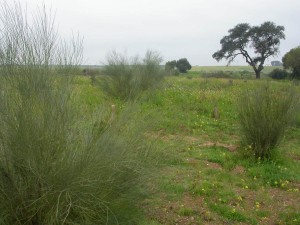
Researchers from IRNAS-CSIC have studied the usefulness of the nurse effect for the revegetation of contaminated Mediterranean soils with Holm oak (Quercus ilex subsp. ballota). In particular, they have assessed whether the nurse effect is related to increases in soil fertility and microbial extracellular enzyme activities underneath the shrub plant, using the retama-Holm oak association as a model system. The study was conducted along a gradient of soil contamination in the Guadiamar River Valley, where afforestation with retama shrubs was conducted following a contamination episode. Along this gradient, soil fertility and microbial activity from different microsites (bare soil, retama cover, Holm oak cover and retama + Holm oak cover) was analysed.
Thirteen years after the start of the remediation activities in the area, soil organic matter and nutrient content were scarcely influenced by the development of the vegetation, being similar across microsite types. Likewise, soil enzyme activities were more influenced by the background soil conditions (pH, and organic matter content, modified by the addition of soil amendment during soil remediation) than by the development of the vegetation. In the soils under the cover of the retama-oak association, intense acidification (pH <4) was observed in the most contaminated sites, which resulted in a higher solubility of toxic trace elements and lower enzyme activities (five times lower dehydrogenase and b-glucosidase activities, in comparison to neutral soils).
The results confirms previous evidence that in these systems the facilitation effect of the retama shrubs is more related to the improvement of abiotic conditions (light and extreme temperatures) than to soil biotic factors. They also suggest that improving soil conditions before plantation through amendment application is critical to ensure the improvement of microbial activity at the long-term in such degraded sites.
The study has been published in Ecological Engineering (available online 18 October 2016).
Reference:
[:]
